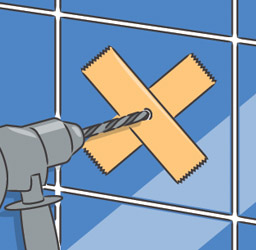 Drilling holes in wall cladding from ceramic tiles can cause some trouble. It is difficult to drill a hole in a marked place, because the blade of the concrete drill when starting drilling slides on the surface of the tile and descends from the drilling site. We can prevent this by sticking a strap of a regular medical slice at the drilling place. From it, the drill blade will not slip and we will drill a hole in a strictly planned place. It is good to stick two stripes on the cross.
Drilling holes in wall cladding from ceramic tiles can cause some trouble. It is difficult to drill a hole in a marked place, because the blade of the concrete drill when starting drilling slides on the surface of the tile and descends from the drilling site. We can prevent this by sticking a strap of a regular medical slice at the drilling place. From it, the drill blade will not slip and we will drill a hole in a strictly planned place. It is good to stick two stripes on the cross.
More reliable screwdriver
The screwdriver easily slips from a straight cut and destroys its ends, Even if the width of the blade is properly selected for the size of the screw head. This happens mainly in colored metal screws and in all these, in which the incision is too shallow. We get a more reliable holding of it by drinking a lightly concave on the forehead of a flat screwdriver. The tips of the blade will then be pressed more accurately to the bottom of the incision near its ends.
Universal installation kit
Frames, that is, assembly elements, They are used to install a hanging sanitary fittings of the washbasins, bidet and toilet bowls. The most commonly used are the shape of a steel frame screwed to the wall and ground. It is then built with gypsum boards and finished by gluing ceramic wall tiles. The sets contain elements for connecting the necessary water and sewage installations. The universal set can be mounted in a wall wall.
Frame -wrapping bathroom
A convenient solution when arranging a bathroom is the use of installation frames attached within one of the walls. If the frames are set up at distances not more than 50-60cm, it can be enclosed with one plasterboard with a thickness of more than 18mm. The condition, however, is the accurate installation of each frame yes, that the foreheads are in one line. Ceramic wall tiles are glued to the screwed plasterboard after priming.
Ceramic tiles systems
Ceramic tiles can be glued to the walls and substrates in various systems, creating a variety of welds and colorful compositions. Most often, however, they are arranged with parallel joints, less often with oblique (at different angle relative to the ground). The oblique system in many cases is characterized by greater aesthetics. However, it requires a much greater amount of work mainly when processing the tiles themselves. Also in this system there will be more waste when trimming extreme tiles. This means buying more.
Perforated tiles
In spatial wooden constructions made of beams, curbing, etc.. Plants with large cross -sections instead of traditional carpentry connections, use the football to connect perforated. The needed shape of the tile is cut out of a larger tile. Parts are connected by screwing the tiles on both sides of the elements. Typical wood screws or karbted nails can be used for fastening. This method of joining is very simple and fast, For this reason, it is recommended for all constructions, which will later be enclosed.
CLOSED INSTALLATION SET
Frames are more and more willing to use in our construction, also called assembly elements. Hanging sanitary facilities are attached to them. Some of these frames after attachment to the wall are framed with bricks, and then cover with glaze. It is worth using this type of rack for hanging toilet bowls, bidet, sinks or urinals. The bathroom equipped in this way has high aesthetic and utility effects.
Hanging toilet bowls
Hanging toilet bowls are more and more appreciated. They are suspended on the frames (sets)installation, then enclosed with gypsum boards and glaze. A cistern is mounted inside the frame, to which access is through the rinsing button. Also, all installations are hidden inside the walls, And this allows you to easily maintain cleanliness and hygiene. The toilet bowl hung in this way (LUB BIDET) withstands the load even 400 kg, So there is no fear of damage under weight.